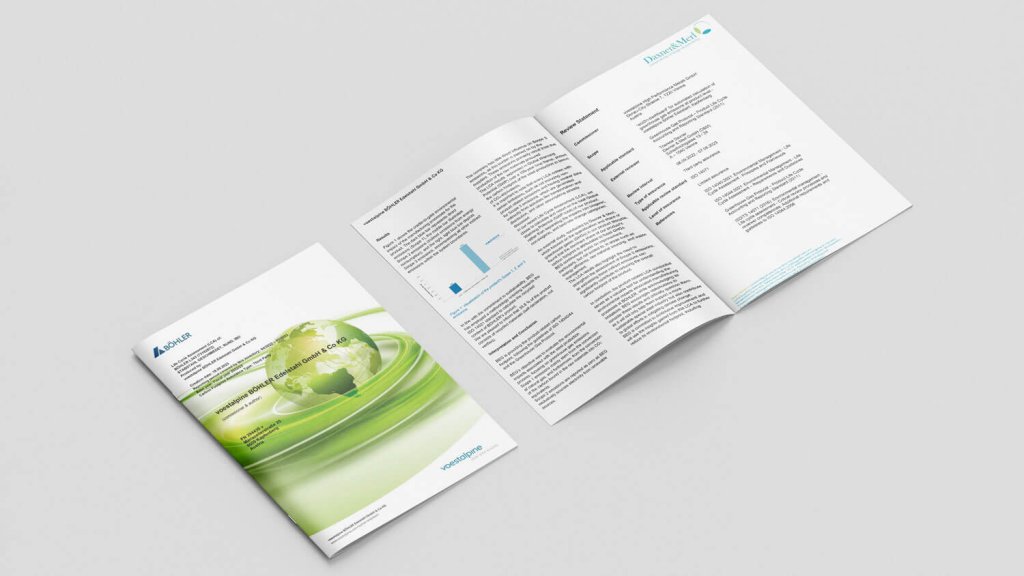eco2nboard: The transparent carbon footprint
Here in the High Performance Metals Division (HPM), we’ve been working for some time already on integrating all aspects of sustainability into daily operations with our “inSPire” framework. Thanks to our newly developed carbon footprint calculations at product level – eco2nboard – we are now able to evaluate the environmental impacts of HPM products even better, and make them available to our customers in a transparent format.
Our company has increasingly shifted its attention to climate change and all aspects of sustainability in recent years. We can also see this taking place in our communication with customers. After all, just like us, our customers are also placing more and more importance on sustainability, and working actively on reaching their sustainability and decarbonisation targets. As a reliable partner, we want to support our customers in these efforts in the best way possible. And so it has recently become possible to present our carbon footprint in great detail at product level.
THE ENVIRONMENT ON BOARD
Acting sustainably and communicating measurable benefits and information about this in a transparent format is becoming an increasingly decisive factor for being able to generate value added for our customers on every level. It’s important to us to carry out activities that enable us to use sustainability as an opportunity and to sustainably support our customers against a backdrop of present and future challenges. Our communications should therefore not only clearly show how HPM solutions optimise performance, costs or capacity utilisation, but also how much energy, emissions and raw materials go into making the products. We have long been able to promptly provide our customers with a somewhat generic overview, although the relevant data at product level had to be calculated individually and manually. Given the rising demand for these specific calculations, in combination with the Division’s extremely diverse products, the HPM experts set about searching for a more efficient solution. The goal: to develop a system for the entire High Performance Metals Division that would make it possible to provide our customers with relevant data on certain aspects of sustainability, quickly and transparently.
VALUABLE REPORT
The result of all these efforts in summer 2021 was the first prototype of eco2nboard, an automated carbon footprint calculation at product level. eco2nboard pursues an interdisciplinary approach. It takes expert knowledge and combines it with relevant data and information from the various departments. To create eco2nboard, we worked in accordance with the latest standards to define which emissions, key indicators and processes are of particular relevance for considering the sustainability of our products: the CO2 equivalents in the Scope 1, 2 and 3 emissions for the carbon footprint as well as the recycled content. Calculating these values requires a holistic approach and automated evaluation for the raw material chains as well as the production and further processing of steel – all the way to the factory gates of HPM. The basic information for the further CO2 calculation comes mainly from the planning data saved in the product cost calculation, which are merged with additional data from other systems as necessary and updated once a year. We generate the values of the Scope 3 emissions using state-of-the-art literature values from an LCA database (= Life Cycle Assessment database). Our Purchasing teams work together with the Sustainable Sourcing experts and our partners on elaborating supplier-specific data in order to be able to illustrate our emissions in the supply chain as accurately as possible.
A BRIEF EXPLANATION: RECYCLED CONTENT OR RECYCLING RATE?
The recycling rate is a key collection indicator and describes the proportion of recycled raw materials in a basic population. It therefore indicates how much raw material was recorded without the product necessarily also having to contain this raw material. The recycled content (secondary raw material content) on the other hand is a material indicator that shows how much secondary raw material the product contains.

ECO2NBOARD: BIG NUMBERS, REALLY CLEAR
Based on these comprehensive data, eco2nboard is finally able to provide our customers with our products’ complete carbon footprint from “cradle to gate”, i.e. from mining the raw materials to the finished product leaving the factory. The figures are automatically analysed at product level with eco2nboard on the basis of a software platform developed in-house and presented clearly in a dashboard; a ten-page, standardised report including supporting information is also generated. The carbon footprint also contains data on direct and indirect emissions in the upstream value chain. “With eco2nboard, we have developed a method that presents the relevant key indicators in a product-specific way. That is still pretty unusual at the present time,” says Oliver Schmitt, who was involved in the initial conceptualisation and production of the eco2nboard prototype.
TOGETHER TOWARDS THE EMISSIONS TARGET
To implement this complex project, HPM relies on the close collaboration between the experts who work in the HPM companies themselves, the teams from Climate Impact, Circular Economy, Sustainable Sourcing and Global Business Process Management, as well as downstream users. Also especially valuable in this regard is the cooperation with local experts at the various HPM locations and their knowledge of the process, systems and procedures on site. “It’s important to look inwards as well as outwards. This way, we can actively support our customers in reaching their emissions targets and at the same time present the advantages of their processes. That will become a basic prerequisite in future for maintaining their competitiveness,” emphasises HPM Sustainable Business Analyst Stefan Schwingenschlögl. “We focus our attention clearly on sustainability and in doing so exercise our responsibility for the future. eco2nboard is an important element of this comprehensive mindset,” adds Florentin Artner, who is supervising the eco2nboard pilot project at voestalpine Böhler Edelstahl.
SUSTAINABILITY REVIEW: THOROUGHLY CHECKED
While developing eco2nboard, our experts also dealt with some quite fundamental questions: what is behind the carbon footprint and recycled content exactly? Which data are relevant for the calculation? It became clear that these questions could not be answered easily or clearly at all. Our customers also had different interpretations because the standards for calculating the carbon footprint were really vague until only a short while ago. “Even today, the standards are still not always specific and further questions remain to be answered. That’s why it’s extremely important for us to be open and to talk more with our customers about sustainability issues,” says Stefan Schwingenschlögl. In order to harmonise the different internal and external definitions and to ensure that the eco2nboard method is accepted by everyone, our calculation was also checked externally in accordance with the standards ISO 14040, ISO 14044 and the Greenhouse Gas Protocol – Product Life Cycle Accounting and Reporting Standard, and subjected to a review in line with the latest standards. In May 2023, the sustainability experts from Daxner & Merl carried out the live review; in August 2023, eco2nboard finally received the review statement for the voestalpine BÖHLER Edelstahl site.

CARBON FOOTPRINT READY ALL OVER THE WORLD
eco2nboard, including the emissions of all Scopes, is currently being developed as a prototype at voestalpine Böhler Edelstahl. Further development and implementation are also being planned for other factories and companies. Work is also currently being done on implementing the automated calculation of the product portfolio for the Uddeholms AB production site. In addition, discussions are already under way about rolling out eco2nboard at Villares Metals and voestalpine Böhler Bleche. In this way, the transparent calculation of the carbon footprint can also be offered in future to as many customers as possible around the world. Moreover, the key indicator “recycled content” will also be integrated and a valid calculation method developed. The Sustainable Sourcing experts are also constantly working on optimising the data situation of the Scope 3 emissions and gradually replacing the current LCA database and literature values with supplier-specific data. “eco2nboard thrives on constant further development. Improving the data quality and constantly optimising the system is an ongoing process,” says Schwingenschlögl.
WANT TO KNOW MORE?
Your direct contact at voestalpine Böhler Edelstahl is happy to answer any inquiries you may have and can be reached at sustainability@bohler-edelstahl.com.
